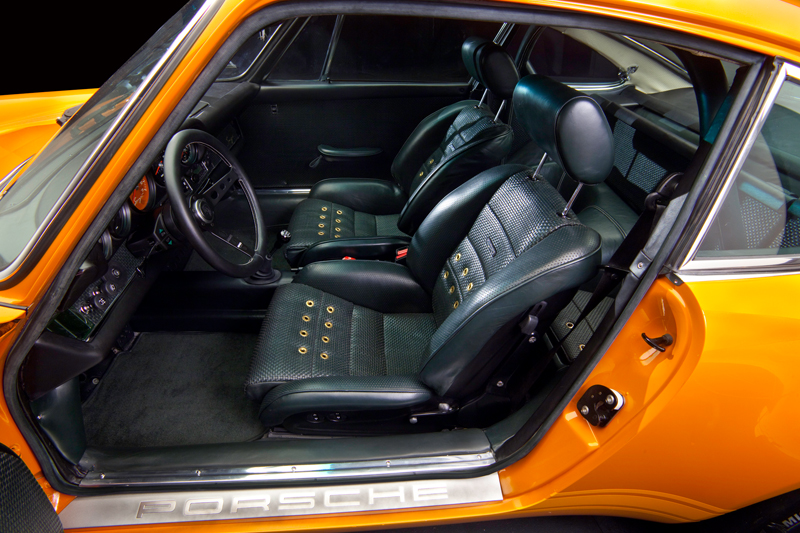Earlier this year, American company Singer Vehicle Design restored, reimagined and rebirth-ed a Porsche classic - putting new technology into an all-time favourite. This is the Singer 911.
The Singer 911 is a re-interpretation and rebirth of the early performance-focused 911’s. The new vehicle is the result of a fusion between the purity of the original 911 and modern materials, design, and updated technologies, and aftermarket experience into a unique sports car that recaptures the essence of the early 911’s golden age.
Beginning with any longer wheelbase 911 (1969 to 1989) donor car, the Singer 911 is stripped to its shell to begin reinvention. The reincarnation retains the original wheelbase, the A-pillar position, the roofline, suspension mounting and transaxle mounting points. Everything else is restored and vastly improved for performance and expression.

The stock 3.6-liter engine is rebuilt to displace 3.82 liters. The engine has been recreated with premium components successfully developed and proven through Ninemeister’s racing exploits. The Singer 911’s engine achieves its displacement with Ninemeister 103mm pistons and cylinders, the 76.4mm crankshaft of the 997 GT3, and the 132mm lightweight titanium connecting rods. The large bore, short stroke combination can spin to 8000 rpm, but offers a broad, flexible torque curve.

Ninemeister’s individual throttle body induction provides maximum tunable power to each cylinder with eye-popping throttle response, and most importantly perhaps, the sweetest 911 exhaust growl imaginable. More importantly, the engine will be managed by an advanced Motec M800 ECU that also adds launch control, traction control, data logging capability - all electronic features never seen on the original 911’s.

Singer will have a tune producing about 360hp with a broad torque curve. For higher performance, a more track focused state of tune offers 425 hp and 340 lbs. ft. of torque. A 997 GT3R oil pump moves oil through the Singer 911’s high capacity dry sump system will be improved with an enhanced fan-assisted cooling system. Race-car spec stainless steel braided hose and fittings are used throughout the Singer 911.

The bulletproof 3.82-liter engine combination is matched to a nearly indestructible six-speed G50 transaxle that has been revised with a close ratio cogs, and a limited slip differential. A twin plate carbon clutch capable of withstanding 700 lbs. ft. of torque and a lightweight flywheel help transmit engine power to the transmission. The 425 hp Sports version explodes from 0 to 60 in 3.9 seconds, 0 to 100mph in 8.5 seconds, and exceeds a top speed of 170 mph.

The Singer 911 is equipped with competition-proven Brembo calipers (4-pot) and rotors that are derived from the 917 and 930 models. The brakes will be peeking out from behind 17" period-evoking Zuffenhaus, lightweight, five-spoke, three-piece forged aluminum wheels.

As for the interior, the Singer 911 features an original 911-style instrument cluster with all-new gauges set in a revised dash panel. The Singer 911 interior is not carpeted in keeping with the traditional feel of the spartan race-focused 911’s (R, ST, and RSR) but will be trimmed in supple dark racing green leather. A re-engineered vintage 911 Recaro seat uses structural carbon fiber in addition to offering fully electric operation and premium leather surface covering. Finally, no vintage, performance focused interior would be complete without a MOMO steering wheel and the Singer 911 features a new interpretation of the company’s classic ‘Monza’ wheel.

Extensive use of composite materials (carbon fiber) for the entire vehicle exterior will leave the door panels as the only original sheetmetal on the Singer 911. The composite materials form an exterior for the Singer 911 that re-invents while emulating the early 911 RSR and ST’s most prominent feature; the fender flares. The Singer 911 prototype is finished in vintage-appearing Singer Racing Orange. Other colors will be available to customers. In addition to the modern interpretation of the lightweight philosophy, the exterior will be updated with a uniquely designed HID headlamp arrangements that greatly improves exterior lighting.

The Singer 911’s aerodynamic performance is improved with a front lip spoiler that reduces front end lift by 12 percent, and a speed sensitive rear spoiler that retracts back into the body (first seen on the 964). Sure the Singer 911 looks like a vintage 911, and maintains some of the same character, but the connections its exterior evokes is unique. There are hints of 911R in the taillights and bumper design, as well as RSR in the bulbous flares, or even some 911ST in the profile, but there is no mistaking that upon closer inspection the Singer 911 is a very different interpretation of these vintage themes. Beneath that “long hood†emulating skin is the heart of the last air/oil cooled 911(type 993) and a host of the latest technology that places the Singer 911 in a place all its own.
